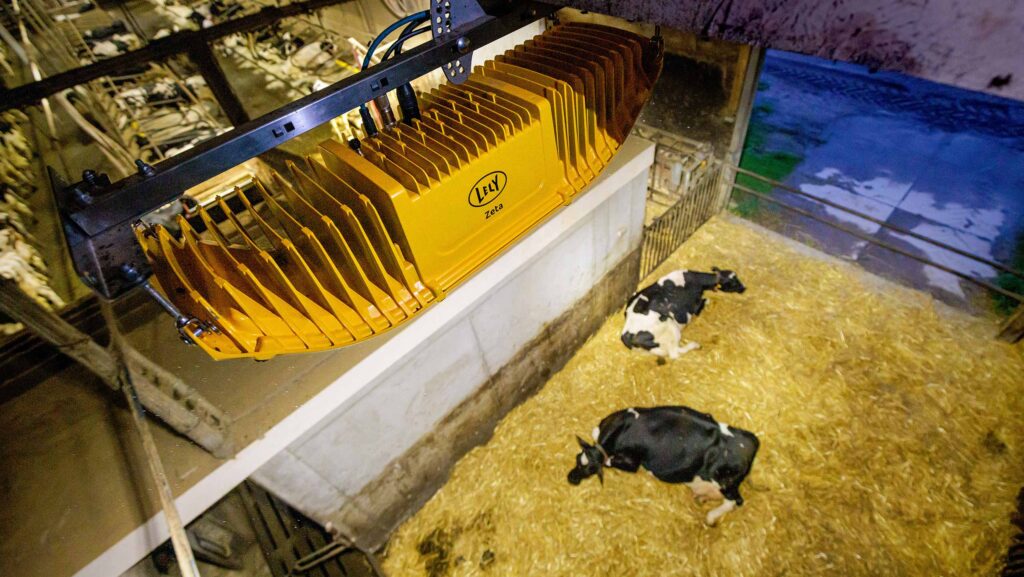Artificial intelligence calving monitor debuts at Dairy Day
 © Lely
© Lely An artificial intelligence-powered calving monitoring system, claimed to be a world first, has been revealed at this year’s Dairy Day.
While calving sensors and cameras are not a new concept, Lely’s Zeta AI system uses a combination of artificial intelligence (AI) and algorithms to collect a myriad of data – which it says will improve both cow welfare and staffing requirements during parturition.
How does it work?
The Zeta is an individual unit, which can be installed above the calving pen. The unit comprises three main components: a camera, an LED light, and an onboard mini-computer.
“The only other requirement is a data cable and a power supply. The data cable links it to the AI-software,” explained Lely’s Andrew Wilson.
See also: Wearable device for cattle aims to improve dairy health
Machine learning does the rest, with the advanced AI trained to recognise the different stages of labour in a cow and detect contractions via patterns of cow behaviour, he added.
Farmers can view and monitor this progression via a live feed on their smartphone, with notifications enabled for contraction scores, active labour and signs of complications.
The LED light allows monitoring 24/7, with a “full moon” mode enabled at night which ensures enough lighting to power the camera, without disturbing cows.
What type of farm does it suit?
According to Andrew, there is no minimum or maximum size requirements for using the system. Instead, the number of units required depends on the size and layout of the shed.
Does it have any other functionality?
As well as monitoring calving, the Zeta also offers barn monitoring. Through this, the system is able to detect oestrus by tracking feeding behaviours and including walking patterns and shed locations into the algorithms to identify the signs.
It can also locate individual cows, as well as monitor/control interactions between cows and any robots in the shed.
Andrew said that as the system continues through the final test stages, more functionality is expected to be added: “Lely has not yet told us 100% of what it can do [but] there will be monitoring for KPIs, cow welfare and cow productivity.”
When will it be available?
The system is currently installed on eight trial farms in the Netherlands.
For UK farmers, the calving module is likely to be the first available and Andrew reckoned it should be launched in 2026. Price point is yet to be confirmed, though may be based on a unit cost plus ongoing subscription model.

© Lely
Sand flush system
A sand-flushing system for Lely’s robotic manure collectors will alleviate the challenges associated with this bedding material.
Using the automated slurry collectors in sand-bedded systems has been problematical because of sediment building up in the collection tank, meaning regular manual removal has been required.
“Anyone who has worked on a dairy with sand will know it’s the single best bedding for dairy cows – but it destroys everything else,” said Lely’s Andrew Wilson.
He adds that the new flushing system can be retrofitted to the Discovery Collector C1 and C2 models and is an optional extra on new purchases.
“It effectively stops the collector filling with sand – and staying full of sand. Every time it goes to a dumping station, it fully dumps all of the manure and the sediment in the tank, which is a game changer.”
Andrew explained that when the collector is full and returns to its docking station, it automatically connects to a water buffer tank. A rear water bag features a pressure-release valve which enables the sediment to be flushed out of the unit.
Once complete, the pressure drops, the valve closes, and the tank refills with water for cleaning.
“The use of sand in dairying in the UK isn’t going away [so] this means the technology is now accessible to a larger proportion of the dairy market – I’d estimated between 30-40% of cows in the UK are now bedded on sand,” he said.
